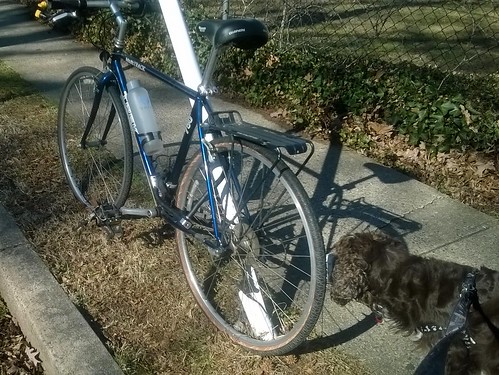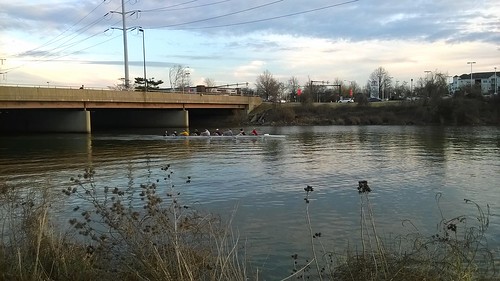"Hexagon is a bike camera that turns your smartphone into a rearview mirror" - article about a new Indiegogo funding effort for the solution to end all solutions for bike safety and anti-safety, all wrapped up in one.
Perhaps it goes without saying, but I am not the demographic this sort of thing is supposed to appeal to - but it's still a free country so I am still allowed to express some opinions, right?
It isn't impossible that someone will come up with a good rationale for attaching a smartphone to your handlebars, but so far I have yet to see one, particularly for recreational riders. For one thing, most of the brackets that hold smartphones in place aren't going to keep the smartphone attached if you have a simple falling accident, so in many cases, the phone ends up on the pavement, smashed. But that is secondary to the contradictions of this particular device.
There are a slew of safety features described - you have a turn signal system, a tail light, a brake light, you have a rear view mirror when the camera's view is displayed on the smartphone, it can provide video evidence if something bad happens, and it even provides parents real time information about a child's ride (with its "new generation parental control system" - by which they mean parents who are out of control, I think). It can automatically notify your emergency contacts if you get in an accident! But then there is important anti-safety feature, that this device encourages live streaming of insane stupid bike tricks. ("Amaze your friends with new tricks through live stream functions.")
"Your rides with Hexagon will be more safe, connected, and fun" - apparently I am a curmudgeon.
When the first diamond frame bicycles became popular in the 1890s they were often called "wheels" - the national cycling association was called the "League of American Wheelmen." We have moved from "wheels" to "bikes," but the bicycles have remained remarkably the same over more than 100 years - elegant in their efficiency and simplicity. And many of the issues that we think are new? They were around then too.
Sunday, March 12, 2017
Saturday, March 11, 2017
Epic Bike Rides of the World (Book Review)
 Epic Bike Rides of the World by Lonely Planet
Epic Bike Rides of the World by Lonely PlanetMy rating: 3 of 5 stars
Lonely Planet seems to have decided to publish more specialized guides - although this isn't a take-it-with-you sort of guide but more of a this-may-inspire-you introduction to possibilities for longer distant cycling (generally at some non-trivial expense, by the way).
The format is puzzling. It isn't a coffee table book, but is large-ish format. Physically it reminds me of a high school text book.
The book covers in some detail fifty different possible cycling routes (as they call them) in thirty different countries, organized by region (Africa, Americas, Asia, Europe, Oceania). The number of routes per region varies widely, with all of two for Africa but nineteen for Europe and fourteen for the Americas. The rides are categorized "easy, harder, epic." For each route, there is a "tools" section that gives some information for someone who might actually be considering one of these rides, but since these are mostly not in one's neighborhood and would require considerable preparation, they are just a bare bones start at the research that would be required.
The photography is nice - again, with the idea to perhaps inspire you.
In a nod at how such information would be presented on a web side, each of the fifty routes ends with brief "more like this" section with another three routes covered in a paragraph. Some of these rides were more interesting to me than the ones covered in details - oh well.
The front cover has the blurb, "Explore the planet's most thrilling cycling routes" at the bottom of it. Perhaps I don't think of "thrilling" the right way. Clearly a few of them are in what I would consider attractive for a thrill seeker, but I would say a more accurate blurb would be "the planet's most satisfying cycling routes." But I guess inspiration needs to be for thrills, not satisfaction.
View all my book reviews.
Saturday, March 4, 2017
America's Bicycle Route (Book Review)
 America's Bicycle Route by Michael McCoy
America's Bicycle Route by Michael McCoyMy rating: 5 of 5 stars
The sub-title of this book is, "The Story of the TransAmerica Bicycle Trail." This is a coffeetable format book published by the Adventure Cycling Association, which I learned from reading this book, came into being as the organization headquartered in Missoula, Montana, that led to the 1976 "Bikecentennial," an organized effort to celebrate the bicentennial with an established route and some support for participants to ride across the country - about 4,100 cyclists did so. Wikipedia has a good short entry about Bikecentennial.
The book mixes history of the Bikecentennial and descriptions and photographs of that event in 1976 with description of the TransAmerica Bike Trail that resulted with coverage from the 1970s through to today, as well as profiles of different riders. It's quite well done. Although it is the kind of thing you don't usually sit down and read cover to cover, I have ended up reading a lot of it. The photography is good with the authors having successfully dug up quite a few photos from the 1970s.
Oddly the Adventure Cycling Association doesn't do anything to make this book available to vendors that provide books to public libraries, so I don't think you will find this in any public library. In fact, it doesn't seem to be available from Amazon, even. To get a copy you have to go to the Adventure Cycling Association web site. (I sent the ACA people an email pointing out it would be a good idea to provide a book like this to vendors that sell to libraries - they could probably sell several more copies of the book and get the word out about their association too.)
View all my book reviews.
Sunday, February 26, 2017
Bike Battles: A History of Sharing the American Road (Book Review)
 Bike Battles: A History of Sharing the American Road by James Longhurst
Bike Battles: A History of Sharing the American Road by James LonghurstMy rating: 4 of 5 stars
This book describes the evolution of cyclist use of roads in America, which got its start before the appearance of automobiles. If today there is some recognition of the need for "complete streets," then this is something we have arrived at after considerable evolution, with highs and lows along the way.
If someone is interested in the history of recreational (rather than racing) cycling in America, this book provides an interesting perspective. If you are a regular bicycle commuter as I am, reading this certainly explains the history of how we got to where we are with some, but not (in my view) enough support for cyclists.
The title overemphasizes conflict in this history, as the author admits - "Bike Battles" sounds more interesting than "Selected Cycling Policy Debates." After working his way from the 1800s through to today, the author's advice to cyclist-policy advocates is to take a moderate approach, recognizing that roads are a shared resource, to be used by motorists, cyclists, and pedestrians.
Some of the information and detail was new to me. I had not known much about the "sidepath" movement, which sought to create dedicated bike paths suitable for cycling at a time when roads used by horse-drawn vehicles were often not suitable for bicycling. This movement never got very far and had various misadventures with how it sought public funding. It somewhat presaged the conflicts closer to the present day between those who favor "vehicular cycling," that is, riding in the road as a vehicle with no special infrastructure for cyclists and those who favor such special infrastructure.
The book includes interesting photographs, many from the National Archives, that I had not seen before to make various points. There are also different instructional videos mentioned, many of which can be found on YouTube with a little searching.
While presented as an academic work, with footnotes and a bibliography, the approach is engaging and readable. I was able to find this at my local public library.

World War II "Victory" bicycle, discussed in the book - a photograph much like this one is include
View all my book reviews.
Saturday, February 25, 2017
Double-Decker Bike Parking for Commuters in USA
![Bicycle shelter, National Cash Register [Company], Dayton, O[hio]](https://c1.staticflickr.com/4/3930/32957219582_6be3423ffb.jpg)
Employee parking in Dayton Ohio in 1902 - back to the future?
![Bicycle shelter, National Cash Register [Company], Dayton, O[hio] - detail](https://c1.staticflickr.com/4/3932/32297952553_b6cf485972.jpg)
Two parking levels of bikes visible in parking shed (or "shelter")
In the detail photograph, you can see clearly that the rider-commuter to the right has a clip (or something) to keep his trousers from getting caught in the front ring of the drive train as well as away from the chain. The fellow in the middle would occasionally work late, it seems, since his bike is outfitted with a headlight.
Bicycle shelter, National Cash Register [Company], Dayton, O[hio]
Contributor Names-Jackson, William Henry, 1843-1942, photographer
Detroit Publishing Co., Created / Published[1902?]
Source Collection-Detroit Publishing Company Photograph Collection
Repository-Library of Congress Prints and Photographs Division Washington, D.C. 20540 USA
www.loc.gov/resource/det.4a20572/
Saturday, February 18, 2017
Another Odd Parked Bike in Neighborhood

Bicycle parked like this near my house for more than a week
This bike appeared in my neighborhood more than a week ago, locked up to a cable that runs from a phone pole. It isn't doing it much good, sitting out in the weather. It's a Trek 750 "MultiTrack" from around 1995 I would guess.

Dog checking it out - yes, it seems to be a bike
This bike is probably about 20 years old - I have a Trek mountain bike of similar vintage, which I like quite a bit. With a little effort a bike like this could be a really good commuter bike. Yet here it is, with its mirror that is falling off, rusting.

My 1995 Trek 930, which is sort of similar
Saturday, February 11, 2017
What One Sees While Commuting

Unusually warm February day brings crew team to Four Mile Run for training

I guess they came up from the Potomac

There were in fact two racing shell and a motorboat
Normally my commute is on the other side of Four Mile Run, where the Arlington water treatment plant is, but at the moment cyclists are supposed to use a detour while some work is done along the north bank.
Subscribe to:
Posts (Atom)